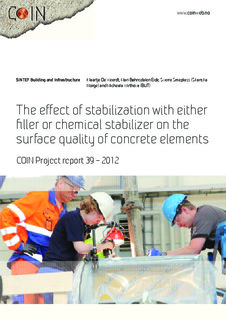| dc.contributor.author | De Weerdt, Klaartje | |
| dc.contributor.author | Eide, Mari Bøhnsdalen | |
| dc.contributor.author | Smeplass, Sverre | |
| dc.contributor.author | Wirthova, Micheala | |
| dc.date.accessioned | 2016-12-07T12:11:34Z | |
| dc.date.available | 2016-12-07T12:11:34Z | |
| dc.date.issued | 2012 | |
| dc.identifier.isbn | 978-82-536-1264-5 | |
| dc.identifier.issn | 1891-1978 | |
| dc.identifier.uri | http://hdl.handle.net/11250/2424514 | |
| dc.description.abstract | Three full scale wall elements were cast with three different concretes: an unstable SCC, one stabilized by adding filler, and one stabilized by adding chemical stabilizer. The aim of this study was to investigate the effect of the stabilization on the rheology of the SCC and on the final surface quality.
All delivered SCC's were rather stone rich and unstable, even the stabilized ones. This was most likely caused by a change in the fines and water content of the sand for which the concrete recipe was not corrected. Even though the SCC's were not as expected certain conclusions could be drawn.
All three mixes had a low viscosity and relatively high yield stress indicating segregation. The questionable stability was confirmed by the sieve segregation test, but not by the visual segregation index on the flow board. Stability assed on a hardened concrete cylinder indicated good stability for the unstable and filler stabilized SCC. However, the chemically stabilized concrete showed clear signs of bleeding.
Regarding the surface quality of the wall elements, it can be concluded that all surfaces had a similar grey level independent of the type of SCC used or whether or not formwork agent was applied. It is not possible to come to clear conclusions as to how the SCC type or the surface treatment affects the amount of pores. However, there is an indication that the chemical stabilizers can lead to large bleeding pores in the lower part of the surface of the concrete wall, whereas filler stabilization can gives rise to the formation of very fine pores.
The fact that all SCC's were on the verge of instability, did not allow for clear rheological differences nor clear differences in final surface quality. | |
| dc.language.iso | eng | |
| dc.publisher | SINTEF Building and Infrastructure | |
| dc.relation.ispartofseries | COIN Project report;39 | |
| dc.subject | Self-consolidating concrete | |
| dc.subject | Rheology | |
| dc.subject | Filler | |
| dc.subject | Chemical stabilizer | |
| dc.title | The effect of stabilization with either filler or chemical stabilizer on the surface quality of concrete elements. FA 2 Competitive constructions. SP 2.1 Robust highly flowable concrete | |
| dc.type | Research report | |
| dc.description.version | publishedVersion | |
| dc.rights.holder | © 2012 Copyright SINTEF Building and Infrastructure | |
| dc.subject.nsi | VDP::Technology: 500 | |
| dc.description.localcode | 3D005940 | |
